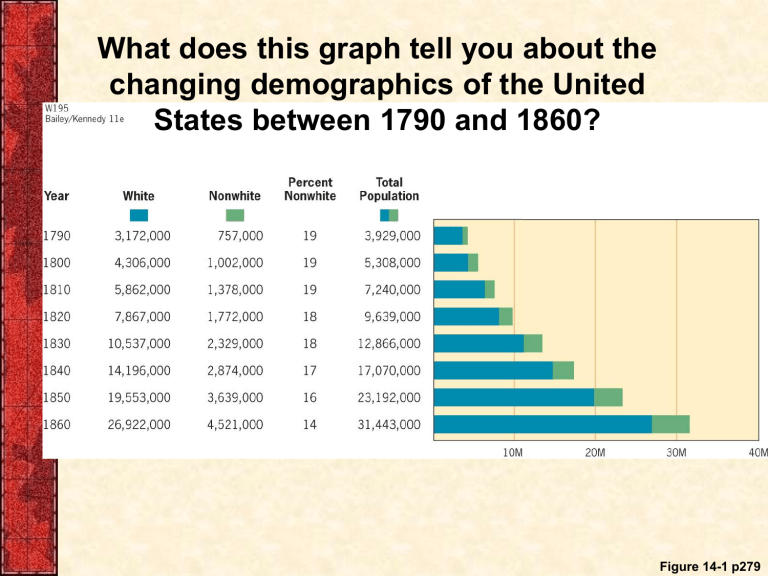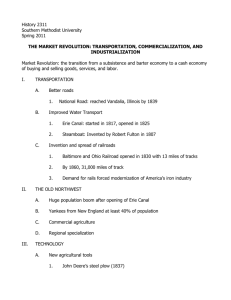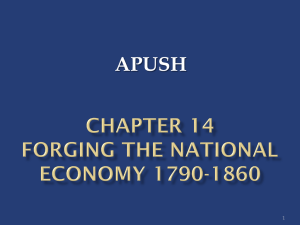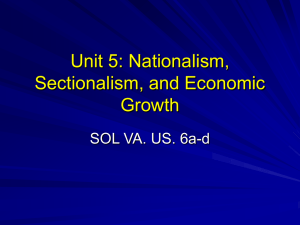American System, Industrialization and

What does this graph tell you about the changing demographics of the United
States between 1790 and 1860?
Figure 14-1 p279
The American System,
Industrialization and
Transportation
1815-1850
Agenda of Powerpoint
• Based on Newman Chapter 8,
• Pageant pg. 256-257, pg.315-337 (Must Read!)
• Focus: Economic Development 1815-1850
– Brief intro to Population Growth
– Political philosophy: The American System
– Key Industrial Innovations and Inventions
– Improvements in Transportation Network
What does this graph tell you about the changing demographics of the United
States between 1790 and 1860?
Figure 14-1 p279
Table 14-1 p279
p284
Growing Pains
– Growing population reflected in relentless pursuit westward
– Nine frontier states joined the 13 original between 1791 and 1819
– This would cause a struggle to keep the balance between North and South (How and why?)
The Compromise of 1820
• 1819: 11 free and 11 slave states
• Missouri was asking Congress for statehood:
– a slave territory
– Tallmadge amendment—
• No more slaves could be brought to Missouri:
• Provided for the gradual emancipation of children born to slave parents already there
• A roar of anger burst from slaveholding Southerners:
– Southern saw the Tallmadge amendment as a threat to sectional balance.
– The future of the slave system caused profound concern.
XII. The Uneasy Missouri Compromise
• Deadlock in Washington was broken by three compromises:
– Henry Clay played a leading role:
• First, Congress decided to admit Missouri as a slave state and at the same time admit Maine as free state
• The balance between the North and South remained for fifteen years
• All future bondage was prohibited north of the line of
36 30’—the southern boundary of Missouri (see Map
12.3).
Hello, my name is Henry
Clay. They call me the
“Great Compromiser.” I learned that skill from my beloved Momma. Click my picture to learn more. p231
“Henry Clay’s American System”
– Nationalism was further highlighted by a plan of Henry Clay for developing a profitable home market:
• The American System:
1. A strong banking system—provide easy and abundant credit
2. High tariffs to protect domestic manufacturing which was centered in the east
3. Improved network of roads and canals, especially in Ohio, that would met the outcry for better transportation.
1. Why is Banking Policy important?
• “easy money ” policy promotes development
– (the student loan analogy)
• BUT…. “easy money” can create inflation, speculation and over evaluation
– (the teenager and the credit cards analogy)
• “tight money” can prevent bad investments and create stability
– (teenager on a debit card analogy)
• BUT… “tight money” can inhibit growth
– (the flip side of the student loan analogy)
1. Banking and the Panic of 1819
• “easy money” policy promotes development
• BUT…. cause severe economic problems because of overspeculation of frontier land
• 1819 Panic paralyzes the economy
– It brought deflation, depression bankruptcies, bank failures, unemployment, soup kitchens, and overcrowded pesthouses—debtor’s prisons
– Factors contributing to the catastrophe:
• West especially hard hit by the Bank of the United
States, forced the speculative (“wildcat”) western banks to the wall and foreclosed mortgages on farms
• (TO BE CONTINUED…….)
2. Why High Tariffs?
– Patriotic Americans took pride in their factories
– The British were seeking to crush Yankee factories in the marketplace
– British manufacturers “Flood” the US market with surplus goods held back
– Tariff of 1816
– It was primarily for protection, not revenue
– Its rates were roughly 20 to 25% of the value of dutiable imports
– A high protective trend was started.
3. Why Transportation?
• Come on… you know the answer!
• So why does Madison veto Congress’ 1817 bill to distribute $1.5 million to the states for internal improvements?
– “intrastate ” v. “ interstate” commerce
– Jeffersonian-Republicans choked on the idea of direct federal support for intrastate internal improvements
– Individual states had to venture on their own for construction programs, including the Erie Canal, which was triumphantly completed in 1825
– New England particularly strongly opposed it because it would further drain away population and create competing states beyond the mountains
Mechanization of America 1800-1850
• Gifted British inventors in 1750s perfected a series of machines for mass production of textiles:
• They harnessed steam to usher in the modern factory system—the Industrial Revolution
• Resulting in a spectacular transformation in agriculture
• As well as in methods of transportation and communication
• Overview
Samuel Slater: “Father of the Factory System”
– The factory system spread from Britain— “the world’s workshop”.
– After memorizing the plans for the machinery, he escaped to America
– Laboriously reconstructed the essential apparatus in
1791 he put together the first efficient American machinery for spinning cotton thread.
Click my picture to see why mill revolutionized the Rhode
Island economy.
The Industrialization of the North
• New England was singularly favored as an industrial center because:
– Its narrow belt of stony soil made farming difficult and manufacturing attractive
• a relatively dense population provided labor and accessible markets
• shipping brought in capital
• seaports made easy the import of raw materials and the export of the finish product
• Industry quickly spreads to PA, NY and NJ
p288
Tomorrow’s question: Is this what a factory really looked like?????
p288
Eli Whitney and Interchangeable Parts
• As the factory system flourished it embraced numerous other industries:
– The manufacturing of firearms and the contribution of Eli Whitney:
• Interchangeable parts adopted in 1850
• Became the basis of modern mass-production, assembly-line methods
• It gave the North the vast industrial plant that ensured military preponderance over the South
• By popularizing the principle of interchangeable parts, Whitney helped factories to flourish in the
North, giving the Union a decided advantage.
Click on Eli’s other minor invention p289
Cotton Becomes “King” in the South
– Tobacco had begun to exhaust fields
– Removing seeds by hand time prohibited
– Cotton gin revolutionize production
– Insatiable demand for cotton comes from
Britain’s established textile industry and NE emerging textile industry
– This revives the needs for slaves
– Cotton Kingdom pushed westward
IX. Marvels in Manufacturing
– Ironically Whitney, by perfecting the cotton gin, gave slavery a renewed lease on life
– The sewing machine:
• Invented by Elias Howe in 1846
• Perfected by Isaac Singer
• Gave strong boost to northern industrialization
• Became the foundation of the ready-made clothing
• Drove many seamstresses from the shelter of the private home to the factory—human robot—tended the clattering mechanisms (Tomorrow!)
Western Farmers Reap a
Revolution in the Fields
– The trans-Allegheny region—especially the Ohio-
Indiana-Illinois tier—was fast becoming the nation’s breadbasket
• Before long it would become a granary to the world.
– Inventions came to the aid of the farmers:
• John Deere of Illinois in 1837 produced a steel plow that broke the stubborn soil:
– Sharp and effective, it was light enough to be pulled by horses, rather than oxen.
• 1830 Cyrus McCormick invented the mechanical mower-reaper
– It was to the western farmers what the cotton gin was to the South.
Click image to learn more about the reaper. p295
Highways and Steamboats
• In 1790s a private company completed the Lancaster
Turnpike in Pennsylvania, running 60 miles from
Philadelphia to Lancaster
• As driver approached the tollgate, they were confronted with a barrier of sharp pikes, which were turned aside when they paid their toll—turnpike.
• Westerners scored a notable triumph in 1811 when the federal government started the construction of the National Road—known as the Cumberland Road
• This overcame obstacles like
– Noisy states’ righters, who opposed federal aid to local projects
– Eastern states protested against being bled of their populations by the westward-reaching arteries
Highways and Steamboats
• Robert Fulton started the steamboat craze:
– Installed a powerful steam engine, the Clermont:
• It ran in 1807 from New York City up the Hudson River toward Albany—150 miles in 32 hours
• The success of the steamboat was sensational
• Fulton had changed all of America’s navigable streams into two-way arteries, doubling carrying capacity
• By 1820 there were 60 steamboats on the Mississippi and its tributaries
• By 1860 there were one thousand.
p297
XIV. “ Clinton ’ s Big Ditch ” in New York
• A canal-cutting craze paralleled the boom in turnpikes and steamboats (see Map 14.2):
– New Yorkers, cut off from federal aid by states’ righters, themselves dug the Erie Canal, linking the Great Lakes with the Hudson River
• Blessed by the driving leadership of Governor DeWitt
Clinton, the project was called “Clinton’s Big Ditch” or
“the Governor’s Gutter.”
XIV. “Clinton’s Big Ditch” in New
York (cont.)
• Begun in 1817, the canal was 363 mi long
• Went from Buffalo, on Lake Erie, to the Hudson River, on to New York harbor
• The water from Clinton’s keg baptized the Empire
State
• Shipping was sped up as the cost/time dropped
– Other economic ripples
• The value of land along the route skyrocketed and new cities, Rochester and Syracuse, blossomed
• The new profitability of farming in the Old Northwest-
Ohio, Michigan, Indiana, and Illinois—attracted
European immigrants.
XIV. “Clinton’s Big Ditch” in New
York (cont.)
– Many dispirited New England farmers abandoned their rocky holdings and went elsewhere:
– Finding it easier to go west over the Erie Canal, some took new farmland south of the Great Lakes
– The transformation in the Northeast—canal consequences—showed how long-established local market structures:
» Could be swamped by the emerging behemoth of a continental economy
– American goods on the international market; far-off
Europeans began to feel the effects of America’s economic vitality
Map 14-2 p298
XV. The Iron Horse
– The development of the railroad
• It was fast, reliable, cheaper than canals to construct, and not frozen over in winter
• Able to go anywhere—it defied terrain and weather
• First railroad appeared in 1828 and new lines spread with amazing swiftness
– Faced strong opposition from canal builders
– They were prohibited, at first, to carry freight
– Considered a dangerous public menace
• Other obstacles:
– Brakes were so feeble that engineers might miss the station
– Arrivals and departures were conjectural
XV. The Iron Horse
(cont.)
– Numerous differences in gauge—required passengers to make frequent changes of trains
• Improvements came:
– Gauges gradually became standard
– Safety devices wee adopted
– The Pullman “sleeping palace” was introduced in 1859.
• America at long last was being bound together with braces of iron, later to be made of steel.
Map 14-3 p299
Advent of Patents
– Each new invention stimulated still more imaginative inventions:
– Patents give inventor legal protection from copycats
– Insures others can’t profit from ideas
• Decade ending in 1800: only 306 patents were registered in Washington
• Decade ending in 1860: there were 28,000
• In 1838 the clerk of the Patent Office resigned in despair, complaining that all worthwhile inventions had been discovered
Advent of Corporations
• Corporations
– Changes in the form and legal status of business organizations:
• The principle of limited liability aided the concentration of capital
• Laws of “free incorporation” meant that businessmen could create corporation without applying for individual charters from the legislature
IX. Marvels in Communication
• Samuel F. B. Morse:
– Inventor of the telegraph
– Secured from Congress an appropriation of
$30,000 to support his experiment with “talking wires”
– In 1844 he strung a wire 40 miles from
Washington to Baltimore and tapped out the historic message, “What hath God wrought?”
XVI. Cables, Clippers, and Pony Riders
– Other forms of transportation and communication were binding the United States and the world:
• Cyrus Field in 1858:
– What he called “the greatest wire-puller in history”
– The stretching of a cable from Newfoundland to Ireland
– Later a heavier cable (1866) permanently linked the
American and European continents
• Donald McKay:
– The development of the new craft called clipper ships
– They sacrificed cargo space for speed
– Their hour of glory was relatively brief.
XVI. Cables, Clippers, and Pony
Riders (cont.)
• Eve of the Civil War the British won the world race for maritime ascendancy with their iron tramp steamers
– They were steadier, roomier, more reliable and more profitable.
• Stagecoaches:
– Immortalized by Mark Twain’s Roughing It
– Their dusty tracks stretched from the banks of the muddy
Missouri River clear to California (see Map 14.4).
• Pony Express (1860):
– to carry mail speedily the 2,000 lonely miles from St.
Joseph, Missouri, to Sacramento, California; ten day trip
– Lasted only 18 months
XVI. Cables, Clippers, and Pony
Riders (cont.)
• The express riders were unhorsed by Samuel Morse’s clacking keys
– Which began to tap messages to California in 1861
• The swift ships and the fleet ponies ushered out a dying technology of wind and muscle
• In the future, machines would be in the saddle
Map 14-4 p301
XVII. The Transport Web Binds the
Union
– The transportation revolution:
• Was stimulated by the desire of the East to tap the
West
– Western region drained southward to the cotton belt
– Steamboats reversed the flow of finished goods to the western arteries and helped bind the West and South together
– Three decades after the Civil War, canals and railroads out from the East, over the Alleghenies and into the blossoming heartland
– An impressive grid of “internal improvements” was laid
• By the eve of the Civil War, a truly continental economy had emerged.
XVII. The Transportation Web
Binds the Union (cont.)
– The principle of division of labor was applied on a national level
– Each region specialized in a particular type of economic activity
» The South raised cotton
» The West grew grain and livestock
» The East made machines
• The economic pattern had fateful political and military implications:
– Many southerners regarded the Mississippi as a chain linking the upper valley states to the southern Cotton
Kingdom
– They believed that some or all of these states would secede with them or be strangled
XVII. The Transportation Web
Binds the Union (cont.)
– They overlooked the man-made links that bound the upper
Mississippi Valley to the East; intimate commercial union
– Southern rebels would not only have
» to fight Northern armies,
» but the tight bonds of an interdependent continental economy
– Economically, the two northerly sections were conjoined twins




